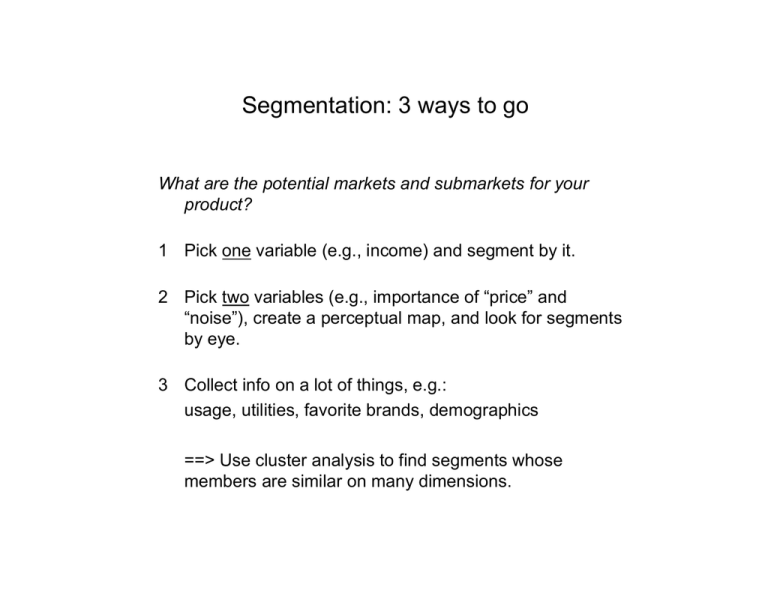Document 13638286
advertisement

Segmentation: 3 ways to go What are the potential markets and submarkets for your product? 1 Pick one variable (e.g., income) and segment by it. 2 Pick two variables (e.g., importance of “price” and “noise”), create a perceptual map, and look for segments by eye. 3 Collect info on a lot of things, e.g.: usage, utilities, favorite brands, demographics ==> Use cluster analysis to find segments whose members are similar on many dimensions. Fine point #1: How do you define similar? Suppose there are only 2 dimensions…(for air conditioners) Linda importance of low noise Bill Chris importance of low price What about more than 2 dimensions? … compute Euclidian distance for each pair Bill Capacity Reliability 6KBtu 0.01 0.05 700 500 400 Price Noise level Vlow Low Moder Linda -0.62 12 5.375 -4.5 -4.25 -1.5 1 1.75 1 Chris -4.5 8.5 7.75 -0.5 -2.98 0.25 2.75 0.25 3 B-L -1.5 6.5 4.25 -1.5 0.5 1 9.25 9 5.75 L-C B-C 15.1 12.3 5.6 16.0 1.6 3.1 3.1 2.3 4.0 9.0 4.0 12.3 1.0 12.1 0.6 42.3 76.6 7.6 0.8 30.3 1.3 9.0 22.6 6.3 68.1 52.6 22.6 7.93 12.86 14.60 Fine point #2 What is distance from a person and a cluster (rather than to another person)? Where does Person X belong? ? importance of low price 1 To the cluster with closest individual (single linkage) 2 To the cluster with closest average individual (average linkage) 3 To the cluster with closest far individual (complete linkage) 4 Ward’s algorithm (minimizes within-cluster variance per # of clusters) Cluster analysis provides the segmentation pattern in the form of a tree With the tree, how do you define the segments? • Draw a vertical line that clips the major (long) branches • Count # of branches (= # of segments) • Try to keep the number small Summary • Cluster analysis will identify groups of people who are similar on many dimensions • To interpret, ask yourself: “What kind of person would have these opinions or characteristics?” i.e., stereotype the cluster/segment • Then add the cluster ID’s to the data set.


